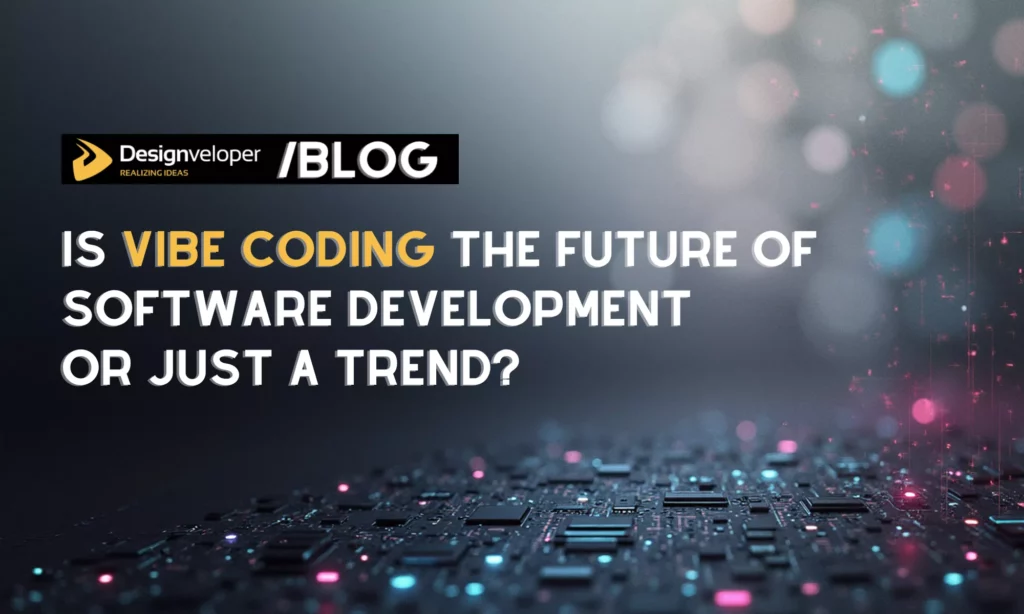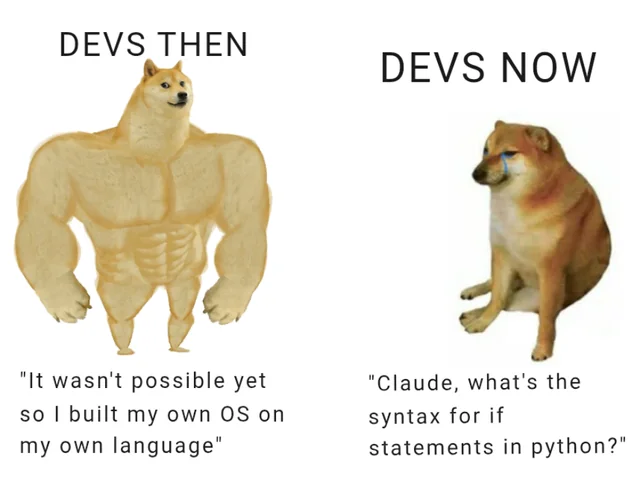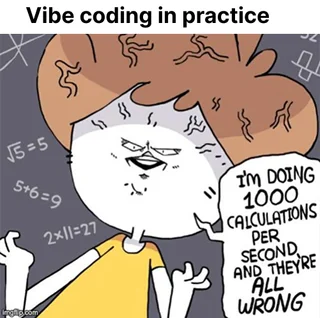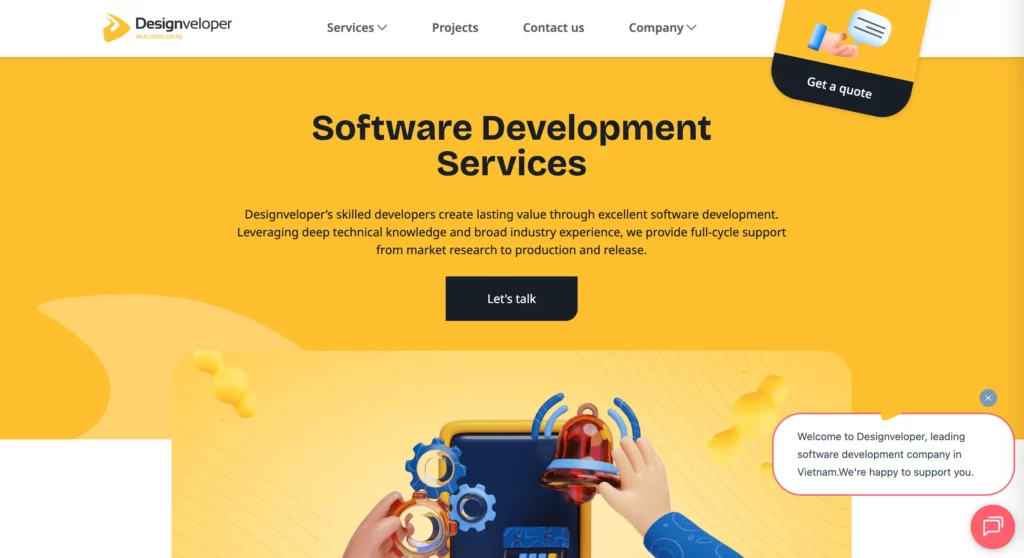Vibe coding, or coding with vibes, is a development approach in which you let AI tools generate code based on natural language prompts without the need to understand or audit their generated codebase.
It first officially appeared in the X post of Andrej Karpathy, a former AI leader at Tesla and also a prominent computer scientist, in early 2025. Since then, the term has gone viral and opened a new page for software creation.
But the widespread adoption of this term raises a big question: Is vibe coding the future of software development or just a trend? The answer to this question is also the main theme of today’s blog post. Keep reading!

The Rise of Vibe Coding
AI-driven code generation isn’t exactly a fresh concept. For years, machine learning tools have been lending a hand – autocompletion, static analysis, and code synthesis have been standard fare in the developer toolkit.
But things took a real leap with the rise of large language models like GitHub Copilot in 2021.
Natural language became the bridge. Now, even people without an engineering background can participate in coding, just by describing what they want in plain English. That’s a serious shift in how organizations approach software development.
The term vibe coding describes the practice of letting an LLM generate the entire codebase, while human developers mainly guide and prompt the code without fully understanding or reviewing every line.
Simon Willison clarified its definition: “If an LLM wrote every line of your code, but you’ve reviewed, tested, and understood it all – that’s not vibe coding; that’s using an LLM as a typing assistant.”
Meanwhile, Andrej Karpathy himself also humorously talked about this new approach in his original post: “I ask for the dumbest things, like ‘decrease the padding on the sidebar by half,’ because I’m too lazy to find it myself. I ‘Accept All’ always; I don’t read the diffs anymore.”
Accordingly, vibe coders let AI do much of the work, while they depend heavily on prompt-based code generation and correction instead of manually auditing the code. This trait turns vibe coding into a “lazy programming” approach for some critics, while others consider it a radical shift in how humans develop software.
Vibe coding democratizes software development. However, it also gives some challenges that trade code quality, security, and maintainability for speed.
Why Vibe Coding Is Trending Right Now
The rise of vibe coding isn’t a coincidence. It’s an inevitable result stemming from the thriving of powerful AI-assisted coding tools, changing developer mindsets, and the impact of online culture. Let’s see how all these factors make vibe coding trending in software development.
The development of AI-assisted coding tools
AI has advanced so rapidly that developers can now simply describe what they need in everyday language, and tools like GitHub Copilot, ChatGPT, or Replit Ghostwriter will generate functional code in moments.
The days of painstakingly writing every line yourself are fading – these assistants make it possible to focus on higher-level problem solving while they handle the repetitive or boilerplate work.
What’s especially remarkable is how these tools, powered by large language models, are getting better at grasping context and supporting a wide range of programming languages. They’re even capable of detecting bugs and offering suggestions on the fly.
As a result, it’s become increasingly standard for developers to lean on AI for routine coding tasks, freeing up time to innovate and address more strategic challenges. This shift isn’t just a matter of efficiency; it’s fundamentally changing how teams approach software development.
Accordingly, developers can use prompts and creativity instead of syntax and technical details to bring simple apps to life. This lays a solid foundation for vibe coding to thrive.
Shifting developer mindsets
Modern developers, whether novice or seasoned, are going through growing pressure to deliver faster and experiment more. Startups require fast prototypes, while established companies demand constant updates and improvements based on user feedback and changing requirements. Even in open-source projects, developers also want to experiment more quickly with new technologies or ideas.
Vibe coding fits perfectly in that scenario. It eliminates some technical complexities (setup, syntax, boilerplate, etc.) to let developers test their ideas or build prototypes quickly without spending hours on manual coding.
For many developers, vibe coding is an effective way to balance development speed and structure, instead of completely replacing traditional coding discipline. Particularly, AI can tackle repetitive coding tasks while human developers focus on architecture, design logic, and creative problem-solving.
The influence of social media & meme culture

Social media and meme culture have also contributed to the spread of vibe coding. The term vibe coding originated from the X post of Andrej Karpathy, an influential figure in the machine learning sector.
One month after the first day of posting, vibe coding was added to the Merriam-Webster Dictionary as a “slang & trending” term. Various articles, podcasts, interviews, and forums like Reddit or Hacker News started using this term playfully to describe working with AI without thinking or reviewing.
The enthusiasm of developers and technophiles worldwide has turned vibe coding into a recognizable trend that blends genuine innovation and fun vibes. Following that are many memes created to describe vibe coding, contributing to its growing popularity.

Is Vibe Coding the Future of Software Development?
It is supposed that vibe coding is the next significant leap in software development. But the reality proves the opposite.
We have to admit that the efficiency of vibe coding depends heavily on the development of AI tools. LLMs are becoming increasingly smart, typically the latest GPT version (GPT-5) which can build simple game apps based on a single prompt.
However, it doesn’t mean human developers can rely entirely on these models to develop software without the need to review or audit their code. Due to some limitations in AI tools, vibe coding is just in its early, experimental phase.
But in which part of software development will this new approach stay? To answer this question, we have to take a detailed look at the benefits and limitations of vibe coding against the traditional development approach (aka structured coding).
Benefits and Limitations of Vibe Coding

Pros
Although many developers often find the idea of coding with vibes funny, it still comes with several practical benefits:
- Faster Prototyping: Vibe coding allows developers to describe what they want in natural language, and then AI takes care of generating the base code. This lets them test software concepts or some features (e.g., login forms or API endpoints) quickly without typing every code line from scratch.
- Lower Entry Barrier for Beginners: AI democratizes code generation, enabling even those without deep technical knowledge to vibe code. AI-assisted coding tools (e.g., ChatGPT or GitHub Copilot), accordingly, help novice developers experiment and learning by implementing small projects. Instead of being bogged down in theories, they can see how code works and which issues may arise through practical examples generated by AI.
- Creativity & Experimentation: Vibe coding tools take care of technical complexities and let developers focus more on “what if” ideas. For instance, they can test various design patterns or frameworks by modifying prompts without coding from scratch. This boosts creative problem-solving and encourages experimentation.
- Increased Productivity for Seasoned Developers: Vibe coding also benefits experienced developers. Using AI, they can handle repetitive tasks (e.g., writing boilerplate code, creating test cases, or producing documentation). This speeds up their development workflow, leaving them more time on architecture design, debugging, and other higher-value tasks.
Cons
The 2025 StackOverflow Developer Survey indicated that up to 84% of developers are using or planning to leverage AI tools in their development process. However, up to 72.2% of all ages said no to vibe coding in their professional development work.
This is not a surprising result. The existing limitations of vibe coding hinder its widespread adoption across large-scale, production-ready projects:
- Code Quality & Maintainability: AI tools generate code based on common patterns found in training data and by forecasting the most likely words/phrases in a sentence. For this reason, their outputs are not always correct, especially in complex or edge situations. Not to mention that vibe coding tools can create unnecessarily complex code, functions, or solutions, hence increasing technical debt and leading to code failure.
- Security Vulnerabilities: When it comes to vibe coding, we often think of saying “yes” to all AI-generated solutions without thorough reviews. However, AI tools are not by default developed to build secure software if we don’t ask them to implement security best practices. Therefore, their codebase is prone to vulnerabilities and unknown systemic issues.
- Skill Degradation & Loss of Understanding: When letting AI do the heavy lifting, junior developers lose opportunities to improve coding skills, algorithmic thinking, and problem-solving through the process of trial, error, and bug fixing. Even in the long term, they gradually lose their deep understanding of how the code works, as they primarily take on the role of guiding and prompting AI rather than manually performing coding tasks.
- Lack of Documentation: When using AI for fast development, developers may ignore writing comments or README files to document the development process. Lack of documentation makes it hard to maintain the software a few months after deployment, let alone making member onboarding harder.
Vibe Coding vs Traditional Software Development
Vibe coding is a new trend in software development. Although it is considered a fun way to create software for hobby or personal projects, vibe coding is still part of software development in the future.
It is closely associated with the development of AI tools. So, vibe coding exists and becomes a new norm in the software development sector, as long as AI is still heavily invested and thrives.
However, how will vibe coding be used for software development compared to traditional approaches in the future? Let’s bring these development approaches to the table to weigh their strengths and weaknesses.
Vibe coding
Vibe coding values speed and creativity. This new workflow highlights a shift from structured, line-by-line coding to prompt-based generation.
Accordingly, developers can tell what they want in plain English, and AI tools will create the code base. This approach allows for high-speed performance, creativity, and accessibility for everyone, including those without deep coding knowledge.
Further, with vibe coding, both novice and seasoned developers can explore ideas, test functionality, and prototype faster without feeling overwhelmed by boilerplate code or syntax. It can even shorten development cycles if your team wants to work on early-stage experiments or products.
However, as we already said, vibe coding tools may generate insecure or inefficient code or produce hidden bugs. If developers don’t understand every code line generated by AI, the lack of manual reviews can lead to failing software.
Traditional software development
Traditional software development has existed for ages. It follows a well-defined process, from requirements gathering, architecture planning, UI/UX design, and coding to testing, deployment, and maintenance.
Each step often requires extensive expertise, careful reviews, and collaboration between different professionals, like developers or QA engineers, to ensure the development workflow runs smoothly.
For this reason, this approach makes software development slower than vibe coding. But in turn, it ensures core quality, security, and maintainability, especially if your team wants to build large-scale and production-ready applications.
Because traditional software development involves so many steps that require extensive technical skills and knowledge, developers have to understand the architecture and technology deeply. This allows them to fix bugs, extend functionality, or optimize the software’s performance when needed.
Future of software development: Blending vibe and structured coding
Given the pros of each development approach, the future of software creation blends their strengths in different stages to achieve the best results.
In the future, vibe coding isn’t a complete substitute for traditional software development, while structured coding no longer exists alone.
Particularly, we’ll see AI tools in early phases (ideation and prototyping). They help validate software concepts by turning ideas into working prototypes quickly. Further, AI is integrated into the entire development process to support repetitive, lower-level tasks, like writing documentation or generating test cases.
Meanwhile, structured coding still proves useful in later phases (production, maintenance, and scaling). They help skilled developers plan the architecture, ensure code quality, integrate security best practices, and enable long-term maintainability.
The Evolution of Modern Software Development

Software development has experienced various transformations from low-level coding to AI. Each phase comes with new development mindsets, new technologies, and new developer roles.
From Early Days: Manual & Low-Level Coding
Software development dates back to the 1940s – 1950s, when computer programmers wrote machine-level instructions manually and worked with limited hardware. Software developed at that time was in its early phase, mainly for military and scientific purposes.
Coming to the 1950s – 1960s, high-level programming languages (e.g., Fortran, LISP, and COBOL) were introduced and facilitated software development. These languages made software development more applicable, especially in commercial data processing and database management systems.
In the 1970s – 1980s, personal computers appeared, making software more accessible to a wider audience. At that time, software development expanded to building word processing software, early PC games, and GUI-based operating systems.
To the Modern Era
Modern software development only started when the world came to the Internet age in the 1990s – 2000s. The introduction of the World Wide Web enabled developers to collaborate globally and encouraged the development of web-based applications (e.g., email services or e-commerce platforms).
Also at that time, new programming languages, like Python, JavaScript, and Java, were born, easing coding, memory management, and system-level instructions. Additionally, frameworks like React, .NET, or Django allowed development teams to create large applications more quickly through their reusable components.
In the 2000s, Agile and DevOps were launched to change the rigid structure of the Waterfall development model. Agile allows for iterative development, continuous feedback, and flexibility; these traits make it ideal for the fast-paced demands of various projects. Meanwhile, DevOps enhances development efficiency by connecting development and IT operations teams.
The 2010s to 2020s witnessed the expansion of cloud and open-source platforms, like AWS, GitHub, and Docker. These platforms changed the way development teams worked. They boosted global collaboration and experimentation through shared repositories, hence making development faster, flexible, and community-driven.
From the 2020s til now (and beyond), we’ve seen the growing adoption of AI in software development in two ways:
1) It’s integrated to make applications smarter in handling tasks (think of AI-powered chatbots as typical examples).
2) It becomes a crucial part of a developer’s toolkit. Early AI tools automated tasks like syntax checking and code completion. But now, LLMs like OpenAI’s ChatGPT, Codex, and GitHub Copilot support developers through natural language coding. This shift introduced a new concept discussed throughout this blog post: vibe coding.
In the future, software development blends human expertise with machine intelligence. Traditional development still matters for code quality, testing, security, and scalability. But AI supports speeding up development cycles.
Developing Software Effectively with Designveloper
Vibe coding is not a new future of software development, but a crucial component. When AI thrives, vibe coding tools may become more accurate in generating code based on a developer’s plain language prompts.
However, AI only proves useful when properly used. And partnering with a reliable, experienced development team is still paramount to the success of your potential software.
Wanna bring your concepts to life but struggle with software development? Let us help you on this challenging journey!
Designveloper is the leading software development and IT consultancy company in Vietnam. Since 2013, we have implemented more than 200 successful projects across sectors, including finance, e-commerce, healthcare, and education.

Whether you want a cross-platform mobile app, an interactive website, or a specialized SaaS platform, we have the right expertise and experience to handle.
We blend common programming languages (Python, Go, Swift, etc.), libraries/frameworks (React Native, Node.js, etc.), and emerging technologies (LangChain, OpenAI’s GPT, etc.). Our high-quality, scalable solutions help clients increase productivity, boost organic traffic, and improve user experience.
Let’s see: We used Golang, Angular, Node.js, etc. to build the ODC platform that connects doctors and patients, especially during the COVID-19 pandemic. Further, we integrate LangChain and OpenAI to develop a customer support service that automatically handles ticket triage. We also blended AI into Korn Ferry Advance to enable personalized career advancement.
At Designveloper, we’ve adopted flexible Agile frameworks and encouraged active communication to deliver the best result. Contact us now and start developing!


